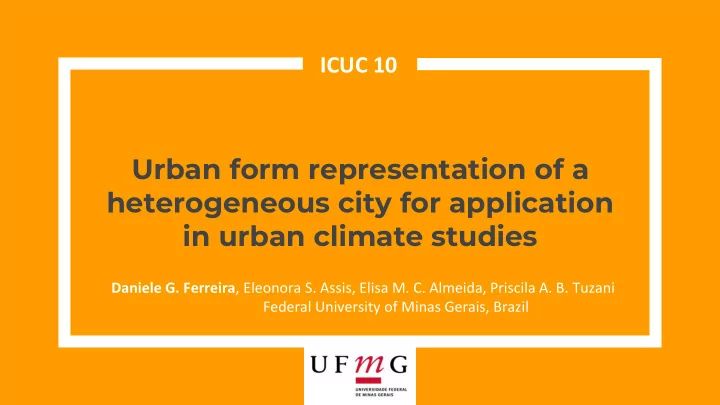

ICUC 10 Urban form representation of a heterogeneous city for application in urban climate studies Daniele G. Ferreira , Eleonora S. Assis, Elisa M. C. Almeida, Priscila A. B. Tuzani Federal University of Minas Gerais, Brazil
INTRODUCTION □ Urban form representation for urban climate studies is a challenge. □ Representation methods □ Qualitative = Area Classifications (Local Climate Zones – LCZ) □ Quantitative = Urban descriptors (real buildings) □ Developing countries : heterogeneous cities □ Urban form is disordered, with informal occupation. □ Land cover types are different from those established in classification models. □ Quantitative methods are possible to apply by increasing capacity of computers.
GOAL Compare 3 methods to represent the urban form of a heterogeneous city BELO HORIONTE, BRAZIL
3rd largest Brazilian urban concentration 7,167 hab./km² population density 4% of the city area is informal occupation ( favelas )
BELO HORIZONTE
METHODOLOGY REPRESENTATION METHODS Classification of Classification by Surface descriptors satellite image number of stories □ h m = mean height of □ low-rise □ up to 2 stories buildings □ mid-rise □ 3-8 stories □ λ p = plan area □ high-rise □ above 9 stories fraction of buildings □ λ c = complete aspect urban land cover (Grimmond and Oke 1999) ratio (Voogt and Oke 1997) QUALITATIVE QUANTITATIVE
INTRODUCTION URBAN DESCRIPTORS λ p = plan area of buildings λ c = complete aspect ratio λ 𝑞 = 𝐵 𝑞 λ 𝑑 = 𝐵 𝑑 𝐵 𝑈 𝐵 𝑈 𝐵 𝑞 𝐵 𝑑 𝐵 𝑈 𝐵 𝑈
RESULTS CLASSIFICATIONS Satellite classification Classes % city % classes low-rise 46% 56% mid-rise 32% 38% high-rise 5% 6% total 83% 100% Building height classifica tion Classes % city % classes ≤ 2 stories 18% 69% 3 - 8 stories 6% 25% > 9 stories 1% 5% total 26% 100%
RESULTS DESCRIPTORS Surface descriptors sample h m (m) λ p λ c 1 6,4 0,31 1,09 2 40,9 0,64 3,87 3 6,7 0,37 1,16 4 6,6 0,16 0,42 5 5,2 0,31 1,01 1 2 3 5
FINAL REMARKS □ Classifications of land cover could not be the best method to represent the urban surface for heterogeneous cities. □ Disadvantages of classifications: □ Satellite image classification ■ Confusion in the recognition of classes. ■ Overestimation of the classified urban area. □ Building height classification ■ Insufficient to represent the impact of the city on climate. □ Surface descriptors □ h m masks the height difference observed in the classification by number of stories. □ λ p shows an area ratio only in one dimension (plan area).
FINAL REMARKS □ Surface descriptors: □ λ c ■ Representation of the three-dimensions of the buildings. ■ Express the density difference and the absolute size of the active surface area responsible for thermal exchanges in cities. ■ Used to represent the city in surface energy balance simulation and also as an input parameter in weather simulations.
THANKS! Daniele Gomes Ferreira dani.gferreira@yahoo.com.br Eleonora Sad de Assis eleonorasad@yahoo.com.br
Recommend
More recommend